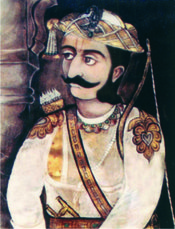Raghuji I
| Raghoji I Bhonsle | |
|---|---|
| Sena Sahib Subah | |
 Raghoji I Bhonsle | |
| Successor | Janoji Bhonsle |
| Born | 1695 |
| Died | 14 February 1755 |
| Religion | Hinduism |
Raghoji I Bhonsale (1695 – February 1755) of the Bhonsale dynasty, was a Maratha general who took control of the Nagpur Kingdom in east-central India during the reign of Chattrapati Shahu.[1] His successors ruled the kingdom until 1853.
Origin
The Bhonsale family were originally headmen from Deor or Deur under the forts Chandan Vandan ,(presently in Koregaon Taluka, District Satara and was under Deshmukhi rights of Bhoite Clan), a village in Satara District. Raghoji's grandfather and his two brothers had fought in the armies of Shivaji, and to the most distinguished of them was entrusted a high military command and the collection of chauth (tribute) in Berar.
Nagpur Kingdom
Nagpur was then the capital of a Gondwana Kingdom ruled by the Gond house of Devagad, who had moved the capital to Nagpur from Deogarh. On Raja Gond's death in 1739, there were disputes as to his succession, and his widow invoked the aid of Raghoji, who was governing Berar on behalf of the Maratha. Raghoji, on being called in by the contending Gond factions, replaced the two sons of Raja Gond on the throne from which they had been ousted by a usurper, and retired to Berar, with a suitable reward for his assistance. Dissensions, however, broke out between the brothers, and in 1743 Raghoji again intervened at the request of the elder brother and drove out his rival. But he had not the heart to give back a second time the country he held within his grasp. Burhan Shan, the Gond Raja, though allowed to retain the outward insignia of royalty, became practically a state pensioner, and all real power passed to the Marathas.

Bold and decisive in action, Raghoji was the archetype of a Maratha leader; he saw in the troubles of other states an opening for his own ambition, and did not even require a pretext for plunder and invasion. Twice his armies invaded Bengal, and he obtained the cession of Cuttack. Chanda, Chhattisgarh, and Sambalpur were added to his dominions between 1745 and 1755, the year of his death. He was succeeded by Janoji Bhonsle.
Battle of Damalcherry
Dost Ali Khan ordered Chanda Sahib to march against the Raja of Tirusivapuram. There upon the raja invited the assistance of the Maratha Empire.
Soon afterwards took place the Battle of Damalcherry in 1740, which was a major confrontation between the Mughal Empire's Nawab of the Carnatic, Dost Ali Khan and his Maratha opponent Raghoji I Bhonsale.[2] The battle was a victory for the Marathas in which Dost Ali Khan, his son and a number of prominent persons of Arcot were killed and resulted in three years of Maratha rule in the Carnatic.[3][4]
Expeditions in Bengal
The Expeditions in Bengal was taken by the Maratha Empire after the successful campaign in Carnatic at the Battle of Trichinopolly. The leader of the expedition was Maratha Maharaja Raghuji of Nagpur. Raghoji was able to annex Orissa and parts of Bengal permanently as he successfully exploited the chaotic conditions prevailing in the region after the death of their Governor Murshid Quli Khan in 1727.[5] Nawab of Bengal ceded territory up to the river Suvarnarekha to the Marathas, and agreeing to pay Rs. 20 lacs as chauth for Bengal (includes both West Bengal and Bangladesh) and 12 lacs for Bihar (including Jharkhand), thus Bengal becoming a tributary to the Marathas.[6]
References
- ^ "Forgotten Indian history: The brutal Maratha invasions of Bengal".
- ^ Jeremy Black (2012). War in the Eighteenth-Century World. 407: Palgrave Macmillan. p. 280. ISBN 9780230370005.
{{cite book}}: CS1 maint: location (link) - ^ Saswadkar, P. L. "Prohibition under the Peshwas in the latter half of the eighteenth century". JSOR. Retrieved 13 December 2020.
- ^ "Brief history of Arcot" (PDF). Tamil Nadu Govt. Retrieved 13 December 2020.
- ^ SNHM. Vol. II, pp. 209, 224.
- ^ Fall Of The Mughal Empire- Volume 1 (4Th Edn.), J.N.Sarka
- Hunter, William Wilson, Sir, et al. (1908). Imperial Gazetteer of India 1908-1931; Clarendon Press, Oxford.
